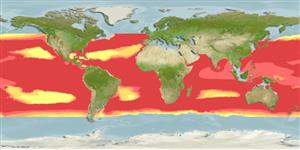>
Lophiiformes (Anglerfishes) >
Melanocetidae (Black Seadevils)
Etymology: Melanocetus: Greek, 'melas' or 'melanos' = black + Greek, 'ketos' = any large sea creature, more often referring to a whale (Ref. 86949); johnsonii: Named for Mr. Johnson of Madeira who found the first individual (Ref. 4525).
More on author: Günther.
Environment: milieu / climate zone / depth range / distribution range
экология
морской батипелагический; пределы глубины 100 - 4500 m (Ref. 74511), usually 100 - 1500 m (Ref. 4118). Deep-water; 50°N - 50°S, 180°W - 180°E
Tropical to temperate parts of all oceans. South China Sea and East China Sea (Ref.74511).
Size / Вес / Возраст
Maturity: Lm ? range ? - ? cm
Max length : 2.9 cm TL самец/пол неопределен; (Ref. 4491); 18.0 cm TL (female)
Краткое описание
определительные ключи | морфология | морфометрия
колючие лучи спинного плавника (общее число) : 1; членистые (мягкие) лучи спинного плавника (общее число) : 13 - 17; колючие лучи анального плавника: 0; членистые (мягкие) лучи анального плавника: 3 - 5. Esca with compressed posterior and anterior crests; anterior margin of vomer nearly straight; minute skin spines present over most of body (Ref. 13608). Branchiostegal rays 6 (Ref. 36493). Caudal-fin rays 8. Scales are cone-shaped, hollow and translucent; with circular base and a free edge pointing towards the caudal region. Left otolith, oblong shape with regular edges, inner face does not present rostrum, antirostrum or cisure (Ref. 41244).
Distinguishing characteristics of metamorphosed female: least outside width between frontals 13.5-28.6% SL; upper jaw with 48-134 teeth, lower jaw 32-78 teeth; length of longest tooth in lower jaw 8.4-25% SL; width of pectoral fin lobe 10.7-17.8% SL; width of escal bulb 4.3-8.6% SL; length of illicium 32.4-60.8% SL; skin with minute spinules over most of body; relatively thick integument 1.55 mm (Ref. 86949). Distinguishing characteristics of metamorphosed male: upper denticular with 9-13 ventrally directed anterior teeth and posteromedial series of 8-11 teeth; lower denticular 12-24 teeth; posterior nostril contiguous with eye; at most 24 olfactory lamellae; skin naked or spinulose (Ref. 86949).
Meso- and bathypelagic (Ref. 58302). Males dwarfed and non-parasitic (Ref. 4491). Caught with plankton nets (Ref. 559). Capable of catching and swallowing prey larger than itself, as witness the approximately 24.0 cm SL specimen of Chauliodus sp. in the stomach of a 6.6 cm SL individual (NMNZ P 14537) (Ref. 58502). Larvae are found primarily in upper 100 m (Ref. 36493). Oviparous, with planktonic larvae (Ref. 36493). Eggs are presumably contained in floating gelatinous rafts (Ref. 36493).
Life cycle and mating behavior
Maturities | размножение | Spawnings | Egg(s) | Fecundities | личинки
Anderson, M.E. and R.W. Leslie, 2001. Review of the deep-sea anglerfishes (Lophiiformes: Ceratioidei) of southern Africa. Ichthyological Bulletin of the J.L.B. Smith Institute of Ichthyology 70:30 p. (Ref. 40877)
Статус Красного Списка МСОП (Ref. 130435)
Угроза для людей
Harmless
Использование человеком
рыболовство: интереса не представляет
дополнительная информация
инструменты
Специальные отчеты
Скачать в формате XML
ресурсы в Интернет
Estimates based on models
Preferred temperature (Ref.
123201): 3.1 - 19.7, mean 7.4 °C (based on 4346 cells).
Phylogenetic diversity index (Ref.
82804): PD
50 = 0.5312 [Uniqueness, from 0.5 = low to 2.0 = high].
Bayesian length-weight: a=0.01995 (0.00906 - 0.04395), b=3.01 (2.83 - 3.19), in cm total length, based on all LWR estimates for this body shape (Ref.
93245).
Trophic level (Ref.
69278): 4.1 ±0.69 se; based on food items.
Fishing Vulnerability (Ref.
59153): Low vulnerability (10 of 100).
